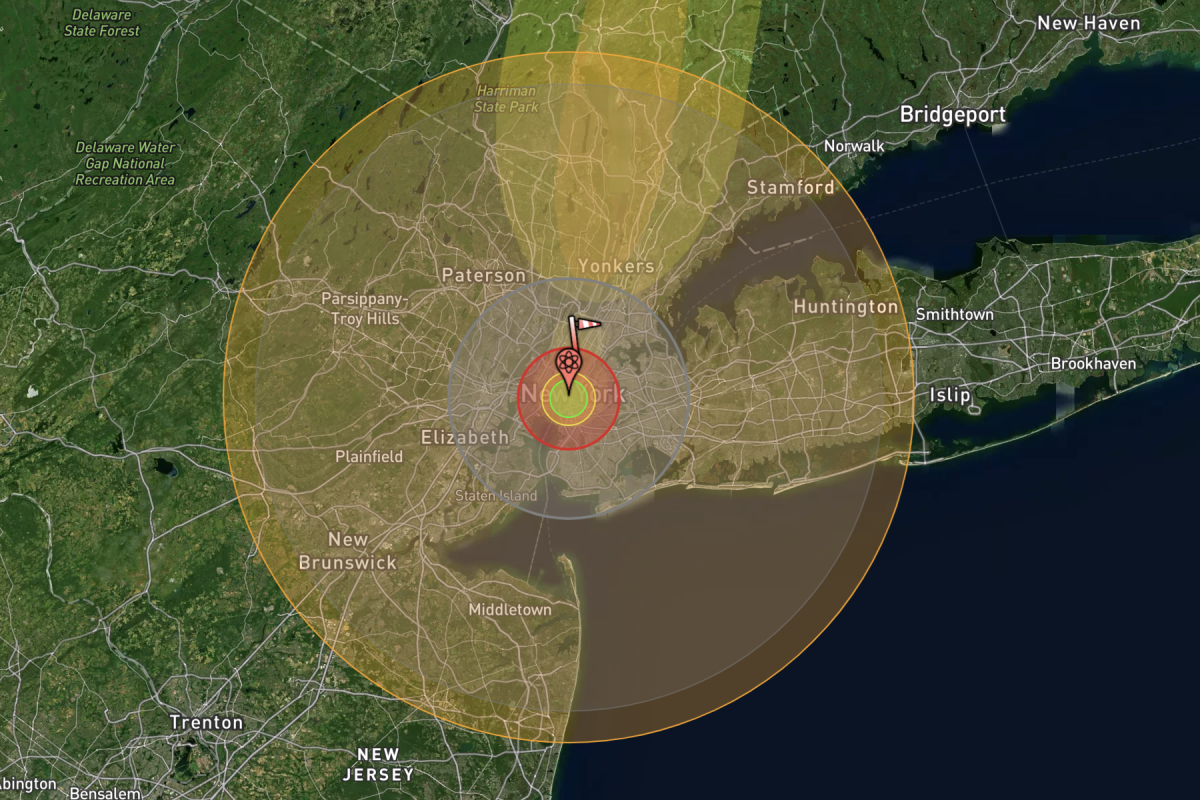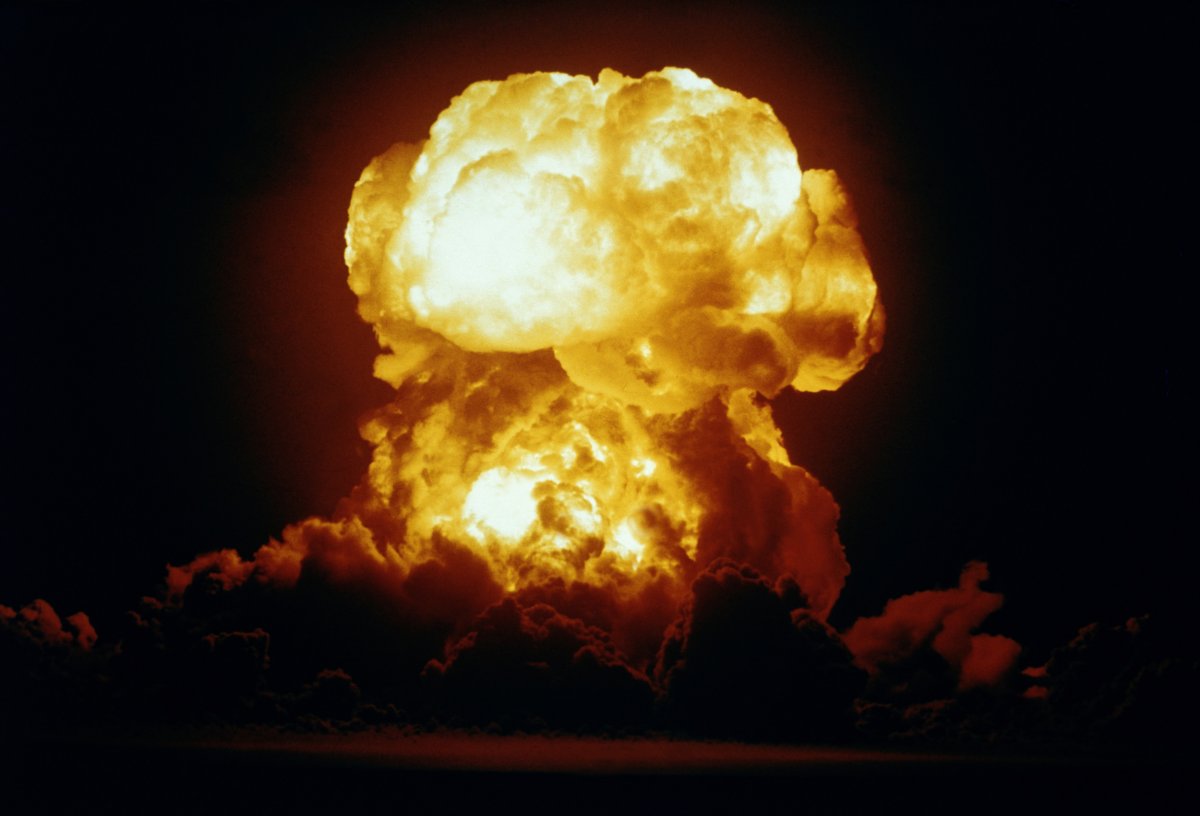Discussions around the threat of nuclear war have escalated in recent weeks, as Sweden and Finland look set to join NATO—and Russia saying it would not accept their membership.
Commentators have been divided on whether Russian president Vladimir Putin would ever go so far as to use these weapons, with some calling them "empty threats," while others saying the risk is real if he feels backed into a corner.
But what would happen if a bomb detonated? What would be the immediate impact and how far would the radiation zone extend?
Alex Wellerstein, a historian of nuclear weapons, who is an associate professor at the Stevens Institute of Technology, in Hoboken, New Jersey, created a nuclear bomb simulator to show just that.
The NUKEMAP is designed to show the effect of a nuclear detonation in any given location across the globe. It consists of a map in which users can select a location and model the local impacts of a blast, while accounting for various factors, such as the power of the weapon and whether or not it detonates on (or near) the surface or up in the air.

The simulation estimates the potential number of deaths and injuries resulting from any given blast, as well as a rough model of where any nuclear fallout will spread and the dimensions of the mushroom cloud.
In the simulator description, Wellerstein said the aim of the educational tool was to help people visualize the impact of nuclear weapons in simple terms in order to help them gain an understanding of the scale of these blasts.
"We live in a world where nuclear weapons issues are on the front pages of our newspapers on a regular basis, yet most people still have a very bad sense of what an exploding nuclear weapon can actually do," Wellerstein said in a statement on the simulator website.
"Some people think they destroy everything in the world all that once, some people think they are not very different from conventional bombs. The reality is somewhere in between: nuclear weapons can cause immense destruction and huge losses of life, but the effects are still comprehendible on a human scale."

The creator said enabling people to visualize the effects in arbitrarily picked geographical locations could help them understand what a nuclear weapon would do to places they are familiar with.
"I created NUKEMAP because it's very hard for anyone—even me—to intuitively understand the sizes of nuclear explosions, much less the differences between different types of nuclear weapons," Wellerstein told Newsweek. "NUKEMAP is made to make understanding nuclear explosions easy for anyone, since pretty much everyone knows how to use online mapping software these days."
Modeling nuclear fallout accurately, in particular, is "very difficult," according to Wellerstein given that there are so many relevant variables, including the type of terrain the explosion is detonated on or over and the weather conditions.
Nuclear fallout is the "short-term" radiation—defined here as the radioactive residues of the explosion that remain active for the next few weeks or months (as opposed to years)—that "fall out" of the mushroom cloud following the bomb's detonation.
This is slightly different to the immediate radiation that it is produced when a nuclear weapon explodes.
As an example, you can use the model to estimate what would happen to the largest cities in the U.S. if a nuclear bomb as powerful as the infamous "Tsar Bomba" was detonated on them.
The Tsar Bomba, which was developed by the USSR in the mid-1950s and early 1960s, was the most powerful nuclear weapon ever created and tested, with a blast yield equivalent to roughly 50 megatons of TNT. As a comparison, "Little Boy"—the nuclear bomb that the United States dropped on Hiroshima during WWII—had a blast yield of around 15 kilotons of TNT, which is around 3,300 times less powerful.
Below are some rough estimates for an airburst detonation of the Tsar Bomba at 13,000 feet above the following cities, according to the simulator:
- New York City, New York - 7.6 million fatalities and 4.2 million injuries
- Los Angeles, California - 3.9 million fatalities and 3.7 million injuries
- Chicago, Illinois - 2.7 million fatalities and 2 million injuries
- Houston, Texas - 1.7 million fatalities and 1.7 million injuries
- Phoenix, Arizona - 1.3 million fatalities and 1.2 million injuries
- Philadelphia, Pennsylvania - 2.3 million fatalities and 1.5 million injuries
Wellerstein stresses that the NUKEMAP model can only provide estimates and is only is good as the data it relies on—which is to say, not perfect. Some factors that could make a difference in the real world when it comes to estimating casualty numbers and the size of a given blast, for example, may not be taken into account in the simulation.
Correction 05/16/22, 10:31 a.m. ET: This article was corrected to say Little Boy had a blast yield of 15 kilotons.
Update 05/20/22, 10:22 a.m. ET: This article was updated to include additional comments from Alex Wellerstein.
Uncommon Knowledge
Newsweek is committed to challenging conventional wisdom and finding connections in the search for common ground.
Newsweek is committed to challenging conventional wisdom and finding connections in the search for common ground.
About the writer
Aristos is a Newsweek science reporter with the London, U.K., bureau. He reports on science and health topics, including; animal, ... Read more
To read how Newsweek uses AI as a newsroom tool, Click here.








